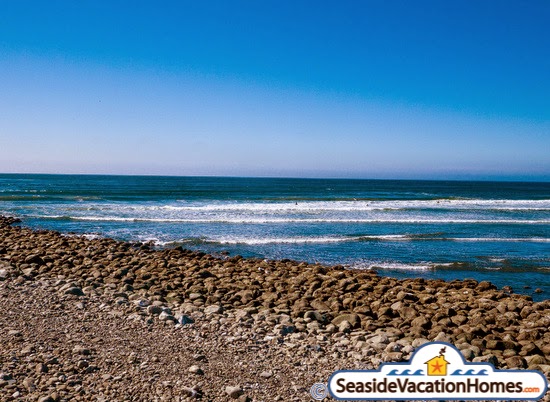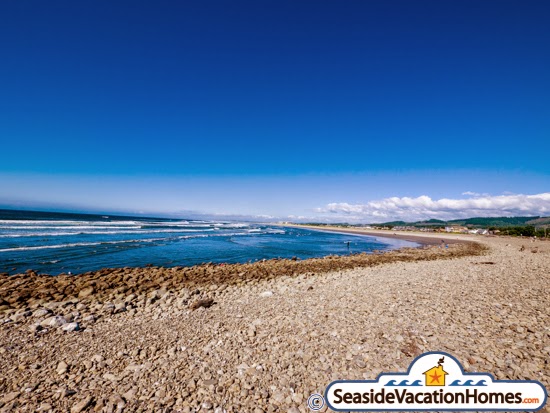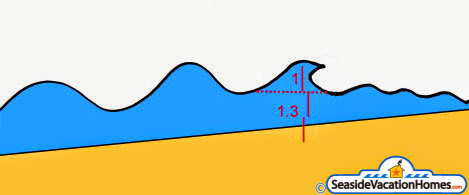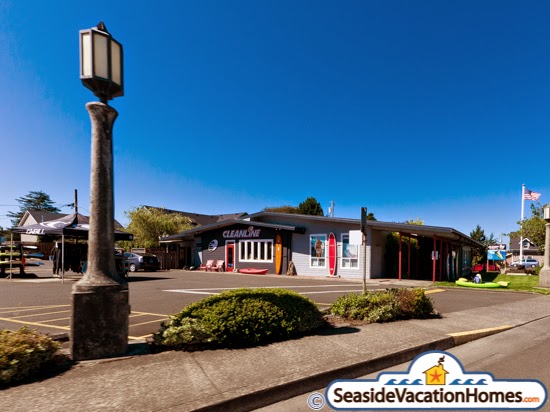Surfing In Seaside, Cannon Beach, Gearhart and Manzanita Oregon

Basic Info About North Coast Surfing: Surfing the north coast provides a great excuse to explore our breathtaking coastline provided you have a good wetsuit! Water temperatures vary from 49-58 F, which is usually enough to chill the thickest of skins. If you don’t have a wetsuit or surfboard they can easily be rented in Seaside and Cannon Beach. Seasonal surfing brings big and often stormy surf in the winter and small gentle surf in the summer. Tides and wind play a factor for advanced surfers but should not prevent beginners from getting out there and splashing around!

Tides and Waves Generally, waves break when they reach a depth of 1.3x their height, so a 1 ft. wave will “generally” break in about 1.3 ft. of water. The type of ocean floor (sand/reef/slab) and speed of the waves will change this dramatically, allowing some areas like pipeline in Hawaii to have hollow waves and others to have crumbly rolling waves.

When the depth changes quickly from very deep to very shallow this makes the top of waves pitch outward,which experts travel the world in search of. If the bottom floor raises gradually it will create crumbling rolling waves, which are best for beginners because they provide a more gradual face to take off on. Tides affect how waves break because most floor bottoms are not a completely even pitch so at high tide waves will be crumbly and low tide hollow (and visa versa depending on the bottom pitch). This video is a great example of a mushy wave.
Waves are produced by prolonged wind blowing across the ocean in a singular direction. The stronger the wind and the more prolonged the breeze the larger the waves will be. For significant surf to occur requires a big storm that will carry on for days. Optimally the storm occurs far away from the coastline so that two things happen: 1. The waves have time to separate such that they don’t break as rapidly one after another, which allows the water to calm between breakers. Calm water allows the depth of the water to remain the same allowing the following waves to break in the same place as the preceding ones. 2. When storms are far out to sea the wind on the coast has a better chance of being calm, creating smooth, bump-free faces! Below is a great example of a steep pitch bottom on a windless day.

When To Surf
The less wind the better is a good rule of thumb to follow. In most areas this means early morning and late in the day when the earth is cool. When the sun warms the earth this heat also accumulates in the air forcing it to rise . Rising air creates pressure systems that ultimately create wind as high pressure naturally moves towards low pressure. As mentioned above, tides also play a key role in wave shape and ride-ability for a given skill level. The best thing to do is stop off at the local surf shop and ask them when the best time is for your experience level and the spot you are most interested in.
Where To Surf
Beginners:
TOP PICK FOR BEGINNERS: Seaside Beach in front of Avenue U is a great place for beginners to advanced surfers. Beginners need to not venture past waist deep, and to be careful dismounting after riding a wave as the water gets shallower the closer you are to shore. In the summer, Seaside Beach is the best spot for beginners to surf because it is the only north coast beach with lifeguards. Be sure to pick a spot on land to stay lined up with as it is easy to drift north or south with currents.
SECOND PICK: Short Sands Beach, located in Oswald West State Park, offers protection from the wind and a very gradual bottom that work together to create awesome waves to learn on. This beach gets incredibly busy with weekend warriors driving in from the city, but don’t let that deter you as there is plenty of beach for everyone. From either of the two parking lots off Hwy. 101 you can enjoy a 10-15 min. downhill walk through old growth forest that ends at a secluded white sand beach. Keep in mind to conserve your energy as it is uphill on the walk back. A great feature of this beach is the fresh water creek that runs adjacent to the trail, which is great for washing off sandy/salty gear on your way out.
THIRD PICK: Indian Beach at Ecola State Park. Indian is a great place to spend the day and catch a few waves. Located in a protected cove on the south end of Tillamook Head, you can easily make memories as this was the location of three notable movies: Goonies, Point Break, and Twilight. This beach can be accessed via a footpath, or for the more adventurous, a swinging bridge located off a trail on the south side of the parking lot. As with Short Sands Beach, a freshwater creek that runs adjacent to the trail offers a great opportunity for washing off sandy/salty gear on your way out.
Experts:
If you are an expert then you will know that it is all about timing, as everything gets good at some point. Document what the direction of the swell is, the tide, and the period of wave interval when you check locations and soon you will know all the secret spots that break when conditions are just right.
What To Surf With
Suits: It is really really important that your wetsuit fit property as it works only by trapping a thin layer of water between the rubber and your skin. Outside of the water your sweat alone will create this layer in a properly fitted suit and with the smallest amount of movement a person can easily go from warm to super hot in no time! If a suit is too tight, it will make breathing and movement difficult, which is no fun. If a suit is too loose, water cannot be held properly and will constantly be flushed through with cold ocean water, making the suit ineffective. Surf shops are pros at fitting suits, however, they run out of sizes from time to time so if they don’t have the next size up or down use your best judgment as to if it will work. A well fitting suit will have minimal wrinkles at the joints/pivot points, be very snug but not restrict breathing, and fit properly on the inseam so that you are not sagging your suit!
Wetsuits come in ratings of millimeters thickness of arms and trunk. A 4/3 will have 4 millimeters worth of rubber on the core and 3 on the arms. This thinness on the extremities allows for better range of motion and a more comfortable suit. On a warm summer day it is possible to get away with a 3/2 suit, however, if the air is chilly it is advised to go with a 4/3 if not more. Some of the thickest suits have three densities, for example, 5/4/3 = 5 chest + 4 Legs + 3 Arms.
Gloves, Booties and Hoods: Simply put = get them. If you find you are hot you can take them off. Without them, even a properly fitted suit is not enough for most people. Once you gauge your comfort level for a certain thickness of suit in a given air temperature, you can decide next time if you really need them. On the North Oregon Coast everyone who surfs year round will have all three even if they don’t always wear all three. Gear is easily rented or purchased at the following surf shops, which will be happy to fit you with the right sizes. Cleanline Surf Shop (Cannon Beach) Cleanline Surf Shop (Seaside) Seaside Surf Shop
Who To Surf With
Local surf shops will have instructors who are knowledgeable and insured. Follow the links above for some great ones! If you want a camp experience, you should check out Lexie’s Northwest Women's Surf Camps. Lexie is very knowledgeable and a super positive person to be around. Even if the weather doesn’t cooperate, she will get you surfing and having a lot of fun! Click on the image below to check out her site, which has a ton of information:




.jpg)

.jpg)

.jpg)